by Ian Skellern
Welcome to the 2019 edition of Quill & Pad’s early Grand Prix d’Horlogerie de Genève predictions in which the team picks favorites and explains why.
The panelists are:
Ian Skellern (IS), co-founder and technical director
Joshua Munchow (JM), resident nerd writer
Martin Green (MG), resident gentleman
Sean Li (SL), editorial director of Blackbird Watch Manual
Tim Mosso (TM), watch specialist and media director of pre-owned watch retailer Watchbox
Note: as jury members, editor-in-chief Elizabeth Doerr and resident collector GaryG do not take part in these early predictions.
The GPHG foundation describes the Mechanical Exception category for watches entered as “men’s and/or ladies’ watches featuring a special mechanism, such as an innovative or sophisticated display, an automaton, a striking or any other acoustic function, a belt-driven movement or any other original and/or exceptional horological concept.”
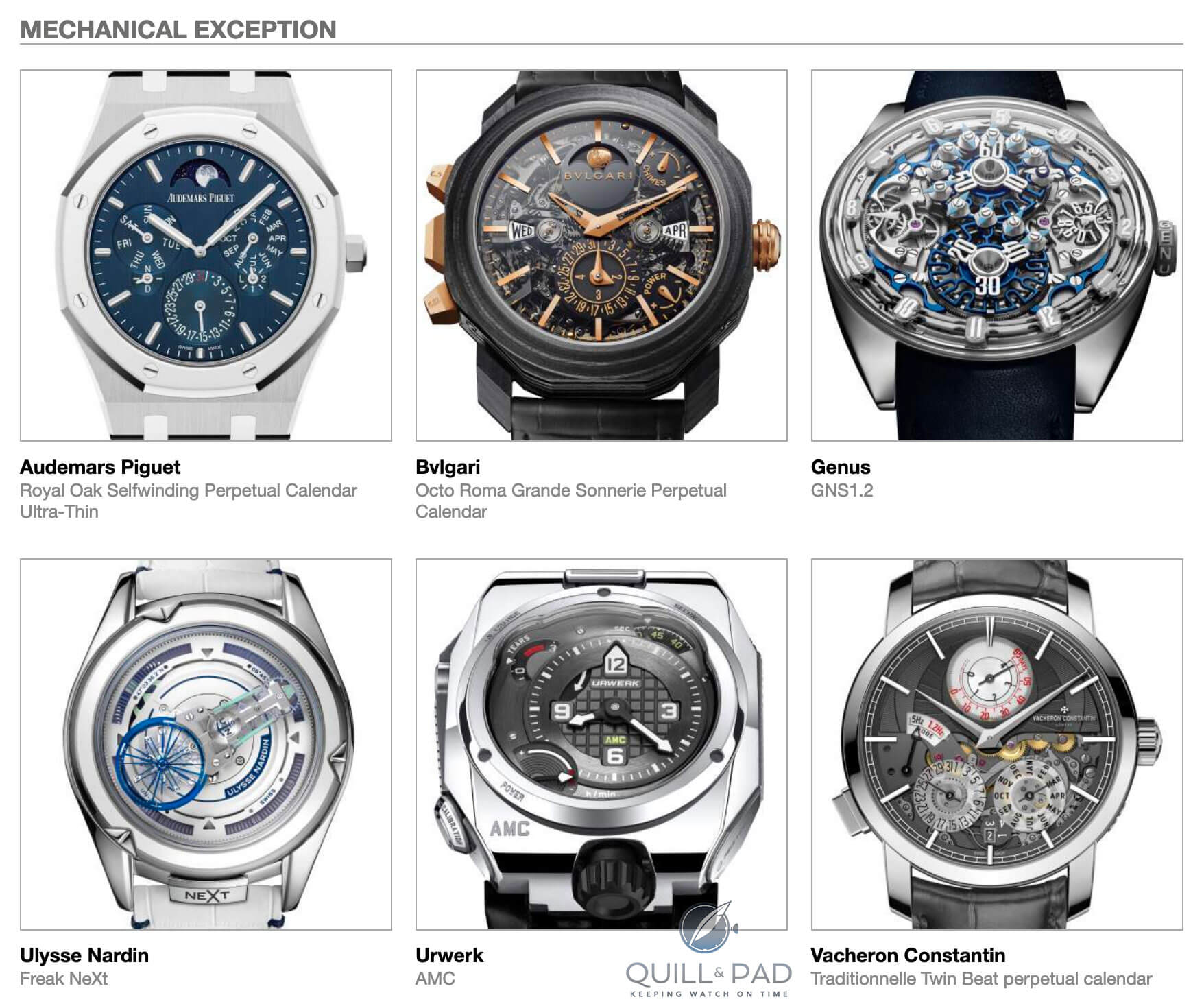
Shortlisted Mechanical Exception watches for the 2019 GPHG: (from top left) Audemars Piguet Royal Oak Selfwinding Perpetual Calendar Ultra-Thin, Bulgari Octo Roma Grande Sonnerie Perpetual Calendar, Genus GNS1.2, Ulysse Nardin Freak NeXt, Urwerk AMC, Vacheron Constantin Traditionnelle Twin Beat
MG: As the resident gentleman of Quill & Pad, I have had a longtime love affair with ultra-thin watches. To me, these represent one of the ultimate complications, though they are not recognized as such (there aren’t even set rules on when “thin” becomes “ultra-thin”). Making a complex watch is one thing, but making such a watch thin makes it exponentially harder to achieve.
IS: If there was any doubt that 2019 is a vintage year for the GPHG, then the Mechanical Exception category blows that away. We have both exceptional classical complications and exceptional avant-garde complications. And even an atomic clock! And (seemingly) paradoxically, I don’t even think that my predicted winner of this category will win this category. Be still my beating heart.
JM: *Sigh* Ugh . . . That is the first thing that came to mind when I saw this ensemble. There are so many fantastic watches for so many different reasons that I am already saying that this category could probably go six different ways. It honestly will come down to what each jury member finds the most valuable expression of mechanics and whether they prefer tradition, experimentation, or straight-up craziness. This category literally has terrific examples of everything plus everything in between. I honestly don’t envy the jury members judging this category because it may just be a coin toss. I personally will always go for progress over tradition, so that’s how I’ll narrow it down. But that is just my preference, and I totally understand a case being made for each and every watch in this group
SL: This is a difficult category because it’s quite open-ended and subject to individual interpretation, Joshua. And, again, it’s made even more difficult by the GPHG’s rules, which say that a particular watch cannot be presented in different categories. There are other watches that could’ve qualified for this one but were not entered as the brands felt they had better chances if considered in another category. This makes the GPHG a little too much of a poker game, in my opinion.
TM: Did I write that the Men’s category was the toughest? Lesson learned: this roster is stacked with heavyweight contenders for the Aiguille d’Or. I would go so far as to propose this year’s Mechanical Exception honor as a potential consolation prize for a watch that falls short of the big one.
Philosophically, this is an academic and conceptual award category; total production of all six nominees combined might not amount to more than 100 units in consumer hands over the next year.
Audemars Piguet Royal Oak Selfwinding Perpetual Calendar Ultra-Thin
SL: At the risk of sounding harsh, I feel that this watch should have been entered in a different category. Don’t get me wrong, it’s very impressive as an ultra-thin perpetual calendar, and executed perfectly by AP. I also like this iteration much better than the concept that was originally presented as RD2 (I might even consider adding it to my collection if it didn’t have a polished bezel). But I think that for a category called “Mechanical Exception,” the formula should go further than ultra-thin + perpetual calendar.
Maybe I’d feel differently if it had been adjustable through the crown rather than hidden pushers, or if you could set the calendar forward or backward at any time. Or I’m just being way too picky. I wouldn’t be all that surprised, though if the GPHG jury picked it to win this category.

Audemars Piguet Royal Oak Selfwinding Perpetual Calendar Ultra-Thin
TM: Audemars Piguet’s new Royal Oak Perpetual Calendar Ultra-Thin is a tour de force. The approachable, orderly, iconic, and wafer-like complications are holy-grail material; take one look at it, and you can see that a legible and practical machine has inherent value even in this whimsical category.
AP did well to bring the innovative Royal Oak RD#2 from 2018 to market in just one year. The engineers from Le Brassus tore apart its 4.31 mm-thick perpetual calendar Caliber 5134 and re-engineered it to measure 2.89 mm. Recall that Caliber 2120 at the heart of the previous 5134 is 2.45 mm thick with no additional modules added. AP shrinkwraps the new mill in a case that’s 6.3 mm thick.
For now, at least, this is the world’s thinnest automatic perpetual calendar. The balanced dial layout and rare full-satin Royal Oak dial ensure that the watch itself remains distinctive and handsome. In other years, this AP might have been machine enough to take the Mechanical Exception prize, but Vacheron Constantin and Ulysse Nardin stacked the deck for 2019.
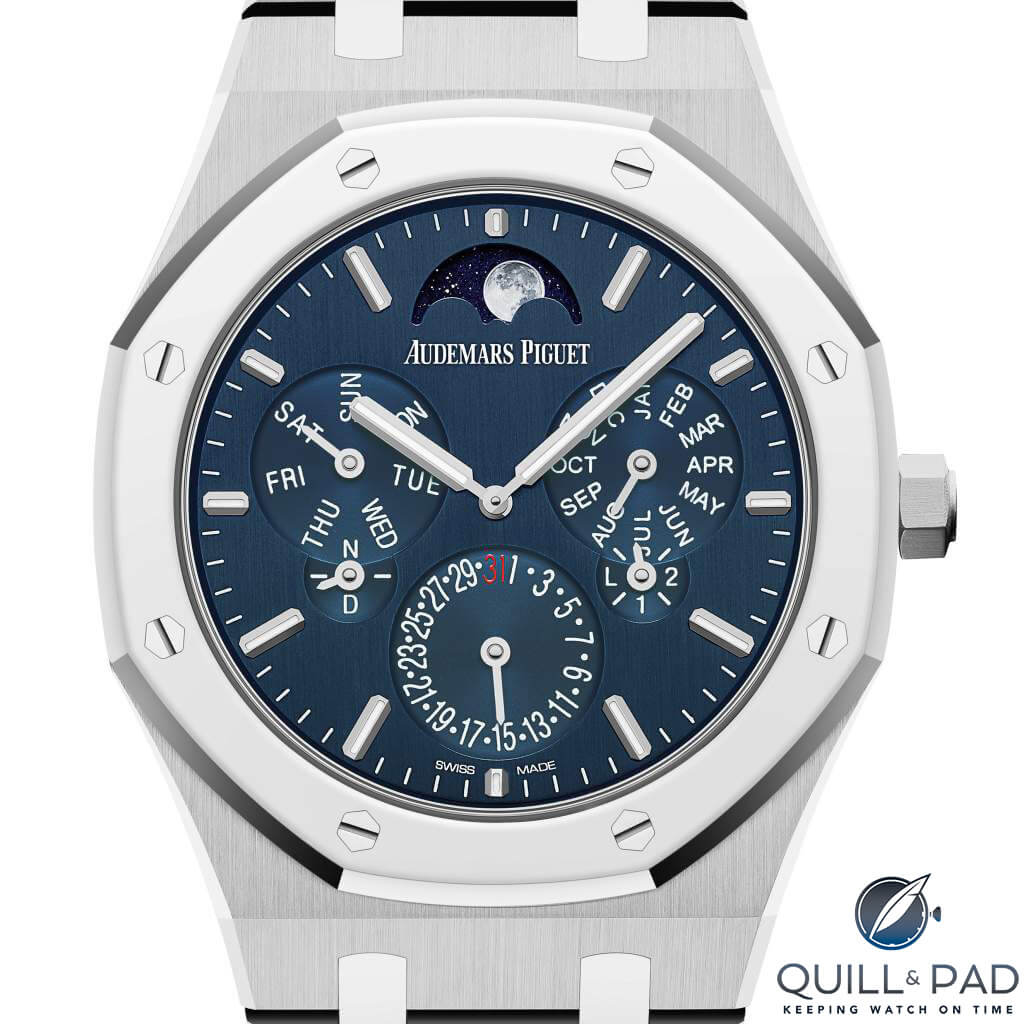
Audemars Piguet Royal Oak Selfwinding Perpetual Calendar Ultra-Thin
JM: The AP Royal Oak QP Ultra-Thin is probably the most understated and wearable watch in this entire category and could be a great everyday watch for anyone, not to mention it features a top-notch perpetual calendar movement from one of the best in the business. On top of that, it is an incredibly thin piece for having a full perpetual calendar, making this a grail watch for many I am sure. I can’t find any faults in this watch for any reason; it is downright a fantastic piece. But, like some pieces in other categories, it’s a bit safe.
It isn’t the same type of dramatic standout watch that the others are in this category, and for that, it feels a tish underwhelming. If anything, it feels like it should have been placed in the Complications category, though then it would have competed against the AP Code 11.59 Supersonnerie. For this reason, I don’t think that it will take the top spot here, which truly is a shame for a superb ultra-thin perpetual calendar.
MG: For me there can only be one winner in this category, guys, and that is this Royal Oak. A fully integrated automatic movement equipped with a perpetual calendar with a height of only 2.89 mm is astonishing. Cased up, the height of this watch is still a staggering 6.3 mm. An accomplishment for which I tip my hat!
IS: As much as I think the Audemars Piguet Royal Oak Selfwinding Perpetual Calendar Ultra-Thin is excellent, a highly legible QP, good-looking, and at 41 mm diameter and a svelte 6.3 mm in height it’s a very wearable wristwatch, I’m surprised at its inclusion here. I appreciate that developing an ultra-thin automatic perpetual is no easy task, but against this competition I think that it will struggle to get votes. That said, I think that Audemars Piguet is likely to be content that this watch, even at around $150,000, is likely to be the largest selling model in this lineup.
For more please visit gphg.org/horlogerie/en/watches/royal-oak-selfwinding-perpetual-calendar-ultra-thin.
Quick Facts Audemars Piguet Royal Oak Selfwinding Perpetual Calendar Ultra-Thin
Case: 41 x 6.3 mm, platinum/titanium
Movement: automatic Caliber 5133, 40-hour power reserve, 19,800 vph frequency; only 2.89 mm height
Functions: hours, minutes; perpetual calendar with date, day, month, year, moon phase
Price: 150,800 Swiss francs
Bulgari Octo Roma Grande Sonnerie Perpetual Calendar
SL: This one approaches the category from another perspective, that of complexity. Again, it’s certainly impressive to be able to combine a perpetual calendar, a grande sonnerie, and a tourbillon into a wristwatch. I also respect the fact that Bulgari has chosen carbon fiber for the case, breaking the mold that chiming watches need to be made out of specific metals to enhance the sound. I guess I’m looking for something more innovative because it’s not the first time that Bulgari has used this specific caliber in a watch.
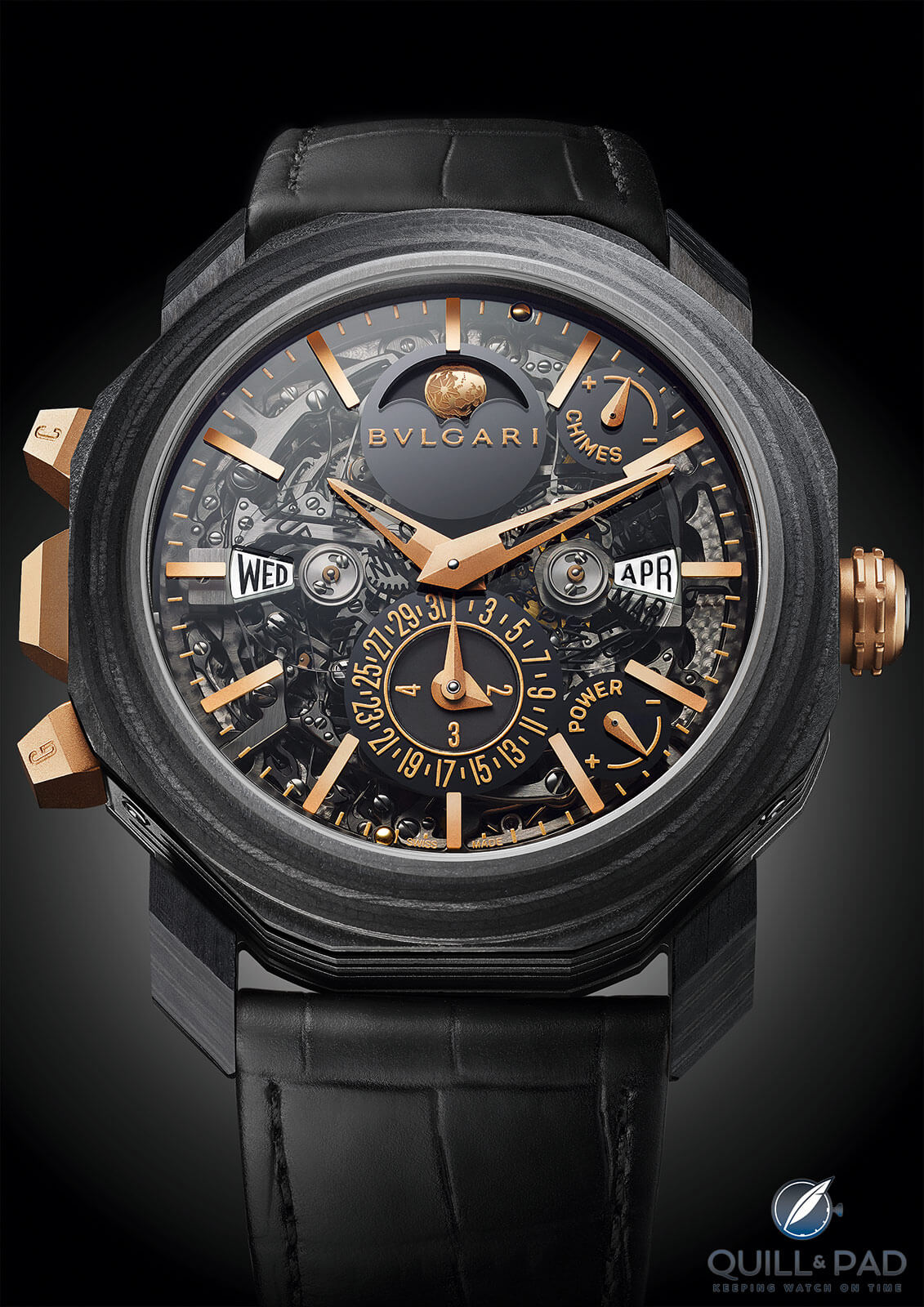
Bulgari Octo Roma Grande Sonnerie Perpetual Calendar
TM: This feels like a rare misfire from the otherwise imperious Octo collection. Sonnerie/perpetual hybrids from Bulgari’s Gérald Genta past betray considerable hand-me-down content on this contender. There’s no doubt that Bulgari’s Octo iteration will age better than the comically dated 1990s Genta Grande Sonnerie, but the magic of this prize category is in the movement, and in that regard Bulgari isn’t working from a clean slate.
IS: I can’t believe I’m writing this, but here we have a watch displaying hours, minutes, date, day, month, moon phase, and power reserve, plus tourbillon, perpetual calendar, minute repeater and grand sonnerie – all in a carbon fiber case – and it doesn’t even make my top three in this competition. That’s no criticism of this Bulgari ultra-complication, but a reflection of just how strong some of its competitors are in this group.
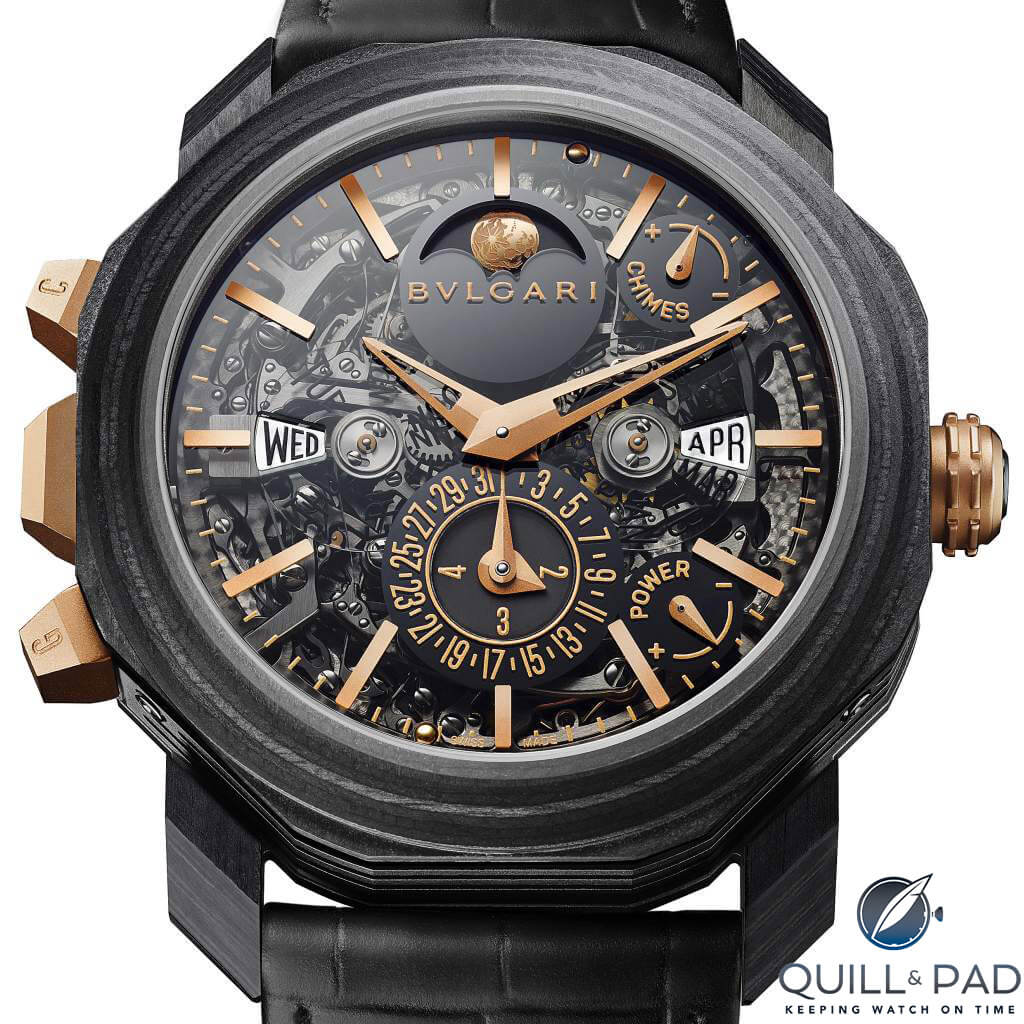
Bulgari Octo Roma Grande Sonnerie Perpetual Calendar
JM: This watch is crazy and bold like Bulgari does so well and combining a grande sonnerie with a perpetual calendar is pretty much the level of a grande complication in my eyes (I know it doesn’t have a chronograph, but oh well). The styling is definitely not for everyone but combining a chiming watch with a forged carbon case is bound to make the sound quality incredible.
The biggest problem with the Octo Roma QP Grand Sonnerie is that, aside from the Octo case and pushers, the dial feels nameless. This piece feels like it lacks the definitive Bulgari flair, and it is a bit messy without a lot of good aesthetic reason. I guess I just don’t vibe with it as much as the other pieces. As that might be the same for others, it will keep it from taking the top spot.
For more please visit gphg.org/horlogerie/en/watches/octo-roma-grande-sonnerie-perpetual-calendar.
Quick Facts Bulgari Octo Roma Grande Sonnerie Perpetual Calendar
Case: 44 x 16.5 mm, carbon fiber CTP with pink gold buttons
Movement: automatic Caliber BVL 980 with one-minute tourbillon, 48-hour power reserve, 3 Hz/21,600 vph frequency, 1,180 components
Functions: hours, minutes; perpetual calendar with date, day, month, moon phase; power reserve indication for both movement and chiming functions, grande et petite sonnerie and minute repeater
Limitation: 8 pieces
Price: 820,000 Swiss francs
Genus GNS1.2
SL: Reading about this watch, I’m not sure if we’re supposed to pay attention to the watch itself or to the watchmaker, Sébastien Billières. The watch certainly fits the bill for this category: it’s like nothing I’ve seen before and complex in a way that my head hurts as I try to comprehend how the display works. The finishing is also very well done. For me, though, the display is a bit too avant-garde; I do like to be able to read the time on my watches, and the learning curve on this one is too steep. I’d say that the brand is one to keep an eye on, to see how Billières can apply his intellect to the future watches and calibers.
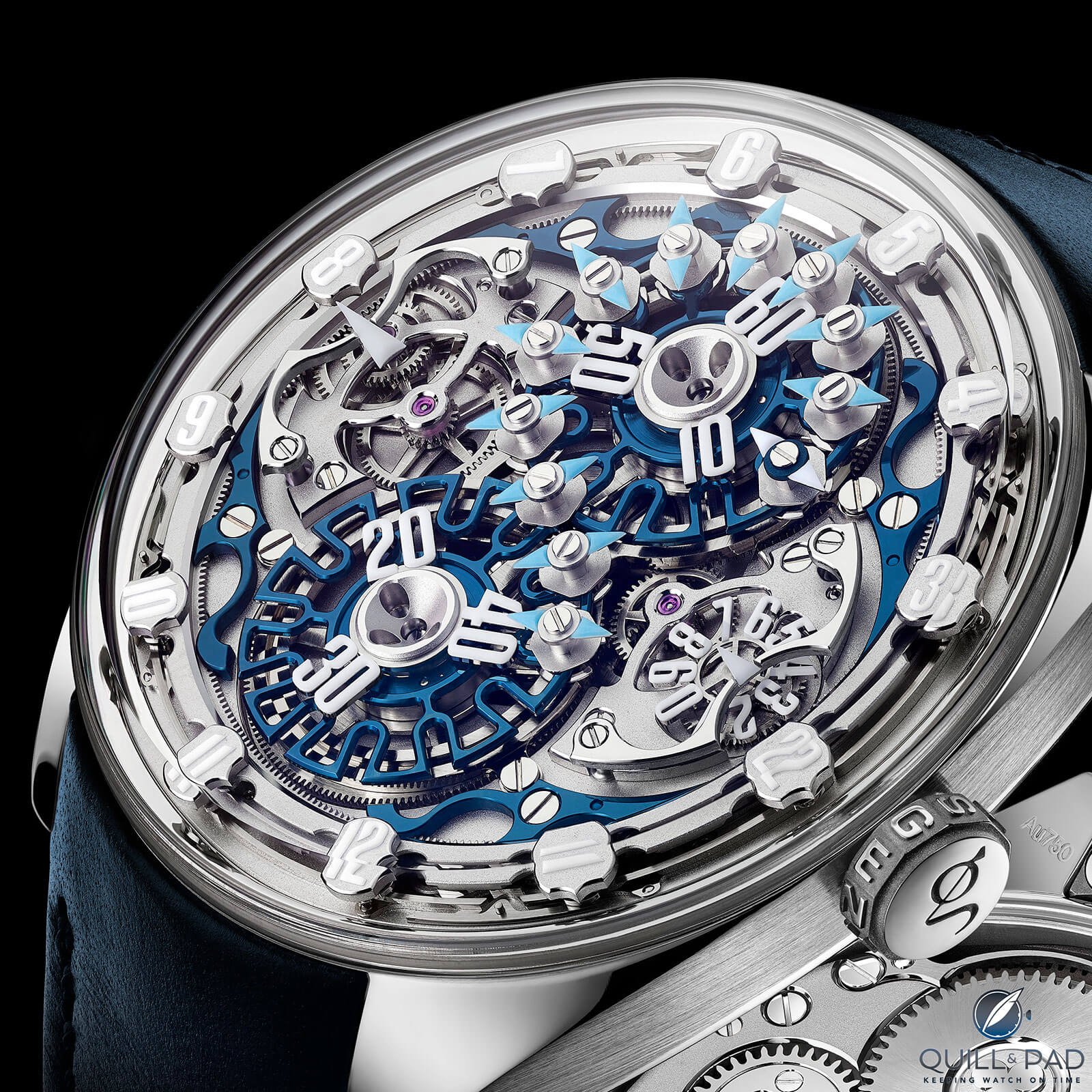
Genus GNS1.2 dial side
IS: I first met Genus co-founder Sébastien Billières over a decade and a half ago when he was Urwerk’s first employee, brought on by Felix Baumgartner to make the Opus 5 watches for Harry Winston. While I’m no expert in judging watchmaking talent, Baumgartner certainly is. And now with a brand of his own, Billières is showing the world what he is capable of: the GNS1.2 would be a sensational Opus series watch.
It’s not easy to understand either how the GNS1.2 works or what makes it so special from static photos. For that you really need a video (or to handle it). But once you see it in operation you think, “How can it possibly do that?”
Pop a tab of LSD or pour yourself a large glass of something strong and come on a trip with me. The hour numerals rotate around the dial with an arrow at 9 o’clock indicating the present hour. And each hour makes a 90-degree rotation every three hours so that they are always right way up and vertical at 12, 3, 6 and 9 o’clock.
Then there are “displays” for each 10-minute mark (10, 20, 30, 40, 50, 60) and single minutes. The single minutes 1-9 are indicated by an arrow at 3 o’clock.
Now hold on tight, this is when it starts to get really crazy!
There are two 10-minute rings, the top displaying 10, 50, and 60 and the bottom 20,30, and 40. Each of those rings rotates every 30 minutes and as they do they pull a string of 11 individual genus (plural genera), which are the little blue double arrows in a figure eight around the two 10-minute disks. That tab kicking in yet?
While those genera look like links in a chain they are all separate pieces, a fact that becomes apparent when a genus leaves one 10-minute ring and smoothly rejoins the other.
The in-house movement is superbly finished and even has a modular escapement (the brand’s own, not a Moser) for ease of servicing.
There’s no denying that the GNS1.2 is a Mechanical Exception watch, but I suspect that understanding and appreciating it fuller might be struggle for some of the jury members – it certainly was for me!
The GPHG might consider making a category for unusual displays and indications. That would encourage more innovation than the Iconic category, which basically rewards most brands for simply doing what they always do: repeat the past. They might change “Iconic” to “Groundhog Day.”
JM: What can you say about the Genus GNS1.2 besides holy cow! The mechanical ideas presented in this watch are visually stunning and entirely unexpected. Having a set of minute indicators that are technically independent from the movement is such a cool accomplishment that most assume they are just on a chain. The execution and finishing on the GNS1.2 is fantastic, and any movement nerd can scour this watch for hours to find interesting details to obsess over. The biggest reason that it isn’t taking the top position in my book comes down to aesthetics (the indications are a bit hard to read) and aside from extremely interesting displays, the watch lacks any extreme technological jump like some others.
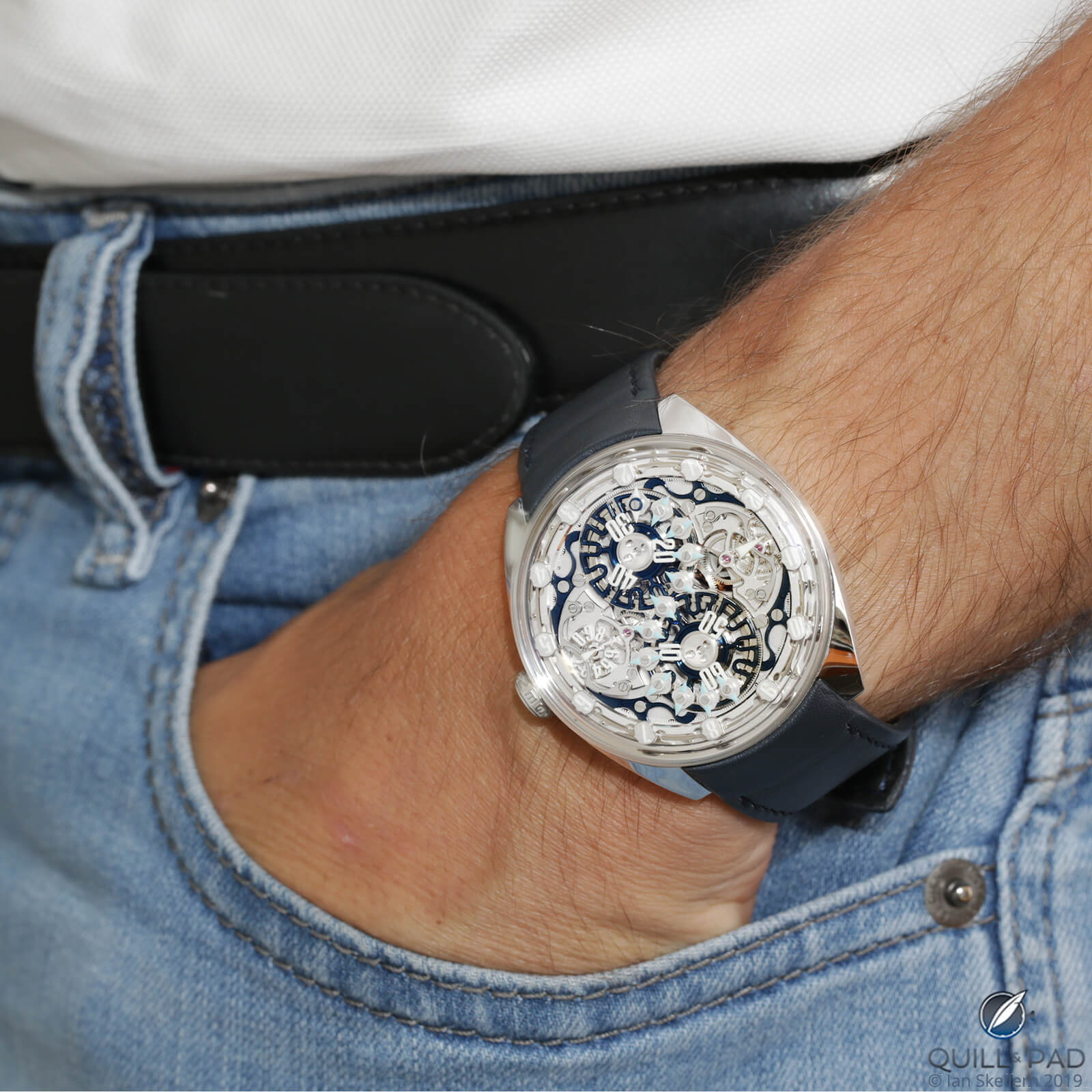
Genus GNS1.2 on the wrist of its creator, Sébastien Billières
TM: I approach oddball time displays like the Genus GNS1.2 with a simple rule of thumb: does the system become second nature or intuitive with repetition? In this case my answer is no, and the result seems like a castoff from the latter years of the Harry Winston Opus series.
While I appreciate attempts to rethink conventional expressions of time, Urwerk, Ressence, F.P. Journe, and even HYT have proved that you can discard dial hands if your solution is designed to be readable first and foremost. The Genus isn’t designed to be read; it’s designed to be seen. And the difference matters.
In motion, Genus’ three distinct time displays look cool, but I find myself squinting and hunting around the dial. The display of ten-minute increments takes the form of an itinerant train that recalls Atari’s “Centipede.” That would be cool if the system moved as quickly as the titular character, but the Genus only becomes lively when being set.
Genus’ finishing is first rate, and I give credit to the company for taking the time to stress detailing and execution of the case back’s traditional watchmaking. Other highlights include a laudable 13.1 mm thickness and a 50-hour power reserve that’s generous in light of the sheer mobile mass of the time display. I don’t want to slam something created by people who clearly love watches, but there’s no broader innovation or practical breakthrough amid all this dial-side chaos.
Further reading:
Introducing Genus GNS1.2 By Sébastien Billières: A Serpentine Turning Point In Horological Indications (With Lume Video)
For more please visit gphg.org/horlogerie/en/watches/gns12.
Quick Facts Genus GNS1.2
Case: 43 x 13.1 mm, white gold
Movement: manually winding Caliber GNS1.2, 50-hour power reserve, 2.5 Hz/18,000 vph frequency
Functions: hours, tens of minutes, precise minutes
Limitation: 8 pieces
Price: CHF 288,500 without VAT
Ulysse Nardin Freak NeXt
IS: “Mechanical Exception” and “Ulysse Nardin Freak” are practically synonymous terms with its silicon flying oscillator beating friction-free at a blistering 12 Hz while simultaneously offering a 30-percent increase in the power reserve (thanks to that friction-free regulator). Then there’s its Grinder winding system, which UN claims is twice as efficient as traditional automatic winding mechanisms. And it’s a Freak!
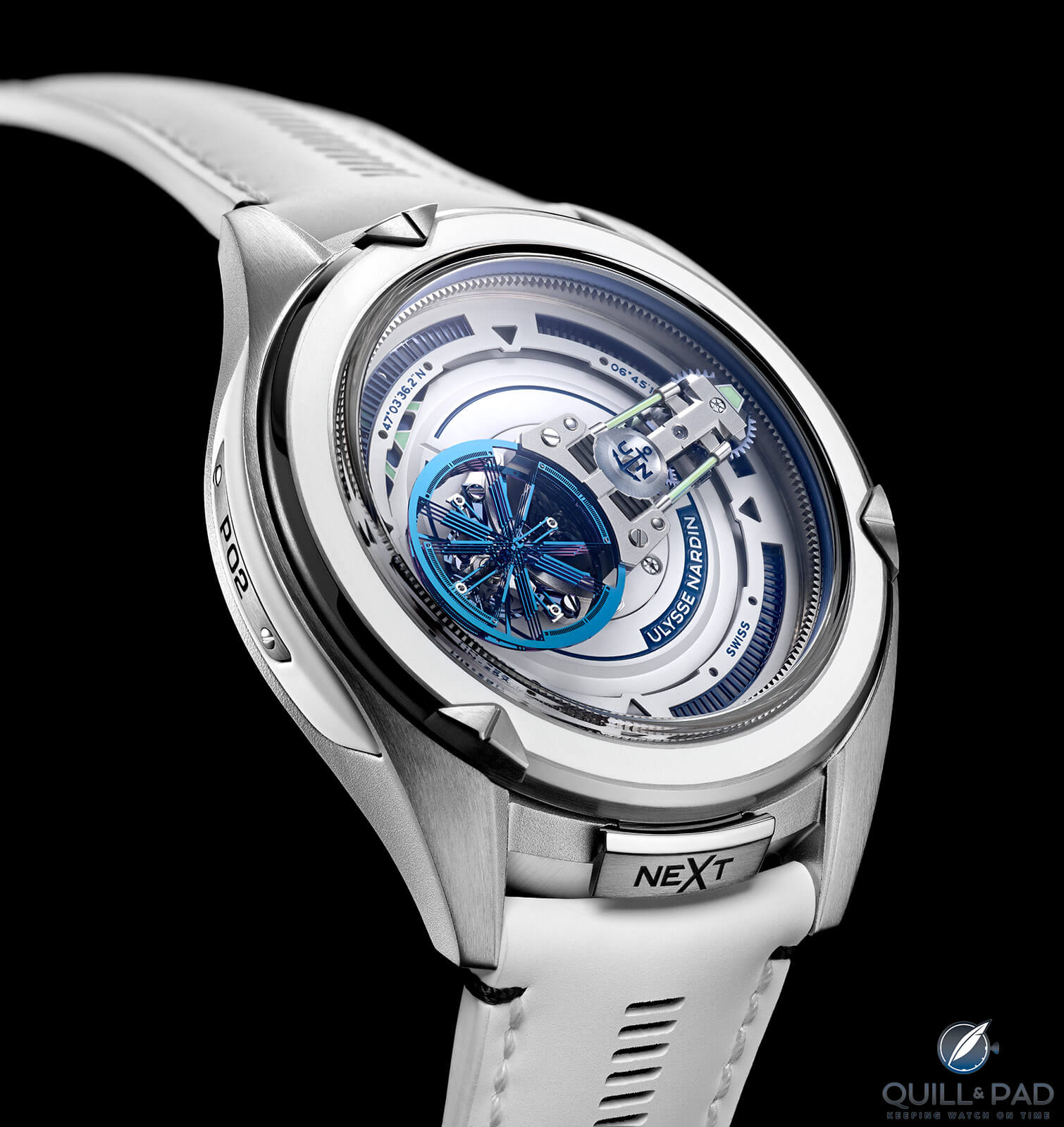
Ulysse Nardin Freak NeXt
The Ulysse Nardin Freak NeXt is an incredible watch and the epitome of innovation (which I love and want to reward). I can’t see how it cannot take the top prize here as the only watch that I think could beat it will be taken out of the running. The Ulysse Nardin Freak NeXt is one of my picks for winner of the 2019 Mechanical Exception category (I don’t like to equivocate, but I have to call a draw in this one).
SL: Ulysse Nardin is going to think I have something against them, which is very far from the truth: but, really, NeXt? Didn’t someone in Cupertino try to launch a computer with that moniker in the late 1980s? Also, I’m really not convinced by this watch’s aesthetics, which unfortunately make me overlook its technical aspects.
TM: Ulysse Nardin’s Freak NeXt is my favorite to take the prize. While the resonating-elastic regulator has been proposed by several parties and actually was brought to market by Zenith, the NeXt’s silicon oscillator is a logical extension of UN’s pioneering work – 2014 to present – with its pivot-less elastic Anchor Escapement. That work pre-dates Zenith’s Defy, and it’s important to note that this Freak also incorporates the Anchor Escapement’s constant-force function – a refinement that the Defy Inventor lacks.
Add automatic winding, a reasonable power reserve of 70 hours, a full silicon drive train, and the fact that UN fabricates rather than buys all of this pricy elastic tinsel, and the Freak NeXt is the most relevant technology showcase in this field. Even if UN only has announced 12 production pieces, I can see a great deal of this tech finding its way into standard Marines and Executives in coming years.
The Freak NeXt and the Vacheron Constantin Twin Beat could take this to a photo finish on technical merits, but I was at SIHH where literally everyone was talking about the Vacheron Constantin Twin Beat as the best in show. That kind of emotional impact is rare for an engineering proof-of-concept watch.
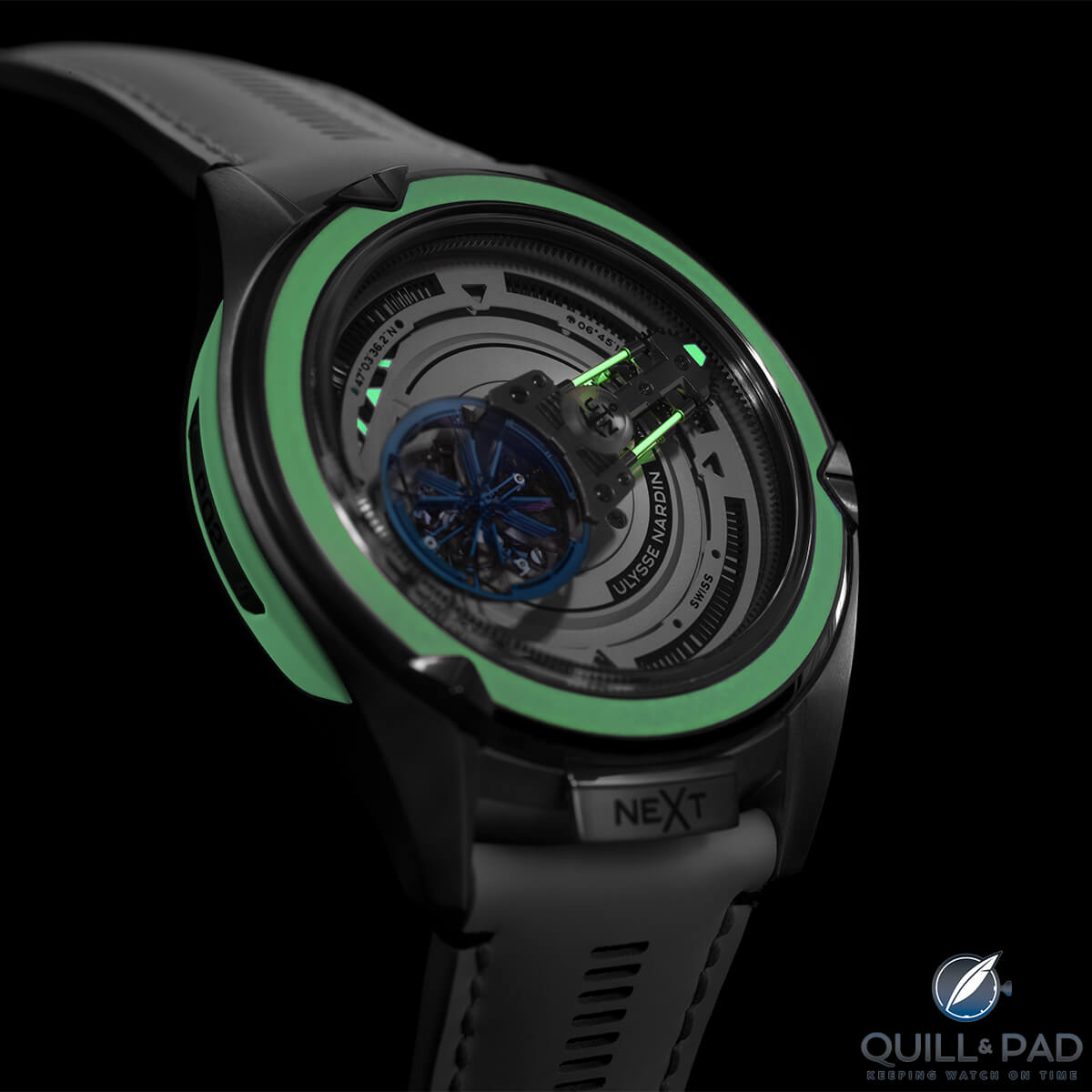
Ulysse Nardin Freak NeXt glowing in the dark
JM: In my third place I have to go with the Ulysse Nardin Freak NeXt. I know, how the heck can I, the lover of all things avant-garde, not pick a UN Freak as the automatic winner!? Well, this year is the year where I have to nitpick over arbitrary things to help me narrow down a winner, and I found a reason to go with another for the winner.
The Freak NeXt is incredible, everything you want from a Freak: innovation, advanced materials, crazy display, and the now-iconic flying oscillator. Specifically, the Freak NeXt debuts a virtual pivot oscillator (meaning it is functionally pivotless) that beats at an intensely rapid 12 Hz thanks to four layers of 32 silicon micro-blades creating a single interconnected oscillator with no friction at all. It does this with an increase in power reserve to 70 hours as well, another significant feat with the dramatic increase in frequency.
The only reason it isn’t my winner is because those are the main things the Freak NeXt does, and in thinking of the Freak Innovision, I’m looking for a whole handbag of innovations packed into the Freak package.
Further reading:
Anchors Away: Ulysse Nardin Makes The Anchor Escapement Viable For The Wristwatch
The Ulysse Anchor Tourbillon By Ulysse Nardin
For more please visit gphg.org/horlogerie/en/watches/freak-next.
Quick Facts Ulysse Nardin Freak NeXt
Case: 45 x 12.8 mm, platinum/titanium with rubber-coated Super-LumiNova bezel
Movement: automatic Caliber UN-25X with silicon flying (suspended) oscillator, Ulysse Anchor Escapement, 12 Hz/86,400 vph frequency, power reserve 70 hours, automatic Grinder system
Functions: hours, minutes, seconds; power reserve display, moon phase
Limitation: 12 pieces
Price: 323,000 Swiss francs
Urwerk AMC
JM: When was the last time you came across a “Sympathique” watch in your travels? The answer is probably never, not to mention the fact that you probably have to ask, “what the heck is a Sympathique?”
The Urwerk AMC has created one of the rarest creations in horology, a watch that can connect to a master system and be automatically adjusted to keep accurate time. This was always a sign of a true watchmaking genius, and Urwerk being who it is decided that it wanted to combine the old with the newest timekeeping technology.
The AMC is the watch side of the AMC system that features an atomic clock base unit keeping time so accurately that one mustn’t worry about being an odd second or two late ever again. Entirely mechanical with a built-in adjustment mechanism and rate sensor, this is the epitome of mechanical timekeeping experimentation. Every other watch in this group is incredible, but the AMC bridges a gap that none of the others can – the atomic – and for that reason I feel it must take the top position in this category (and remain a contender for the Aiguille d’Or).
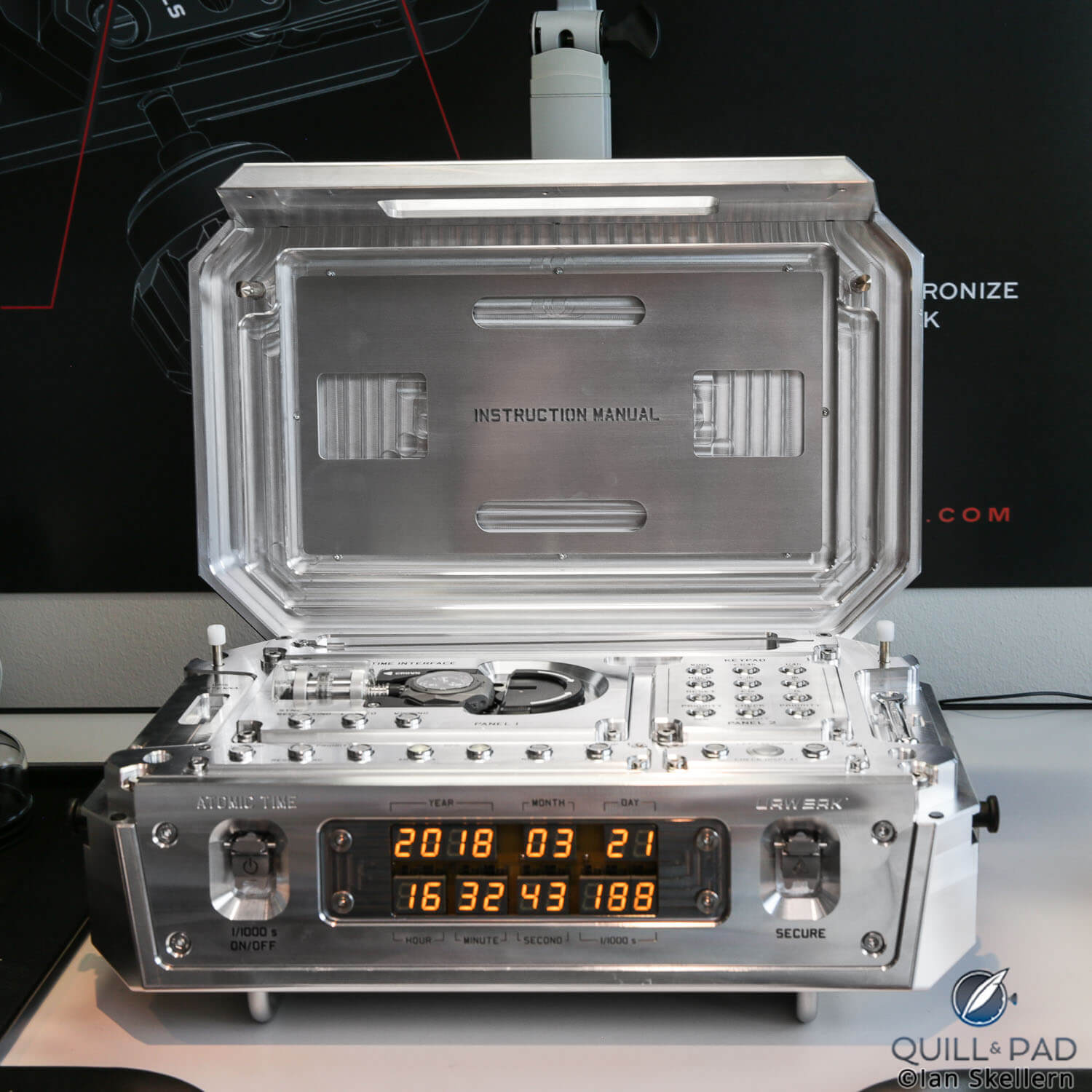
Urwerk AMC docked with atomic clock
TM: Urwerk’s AMC – and the $2.8 million atomic clock that accompanies it – is a wild modern-day tribute to the Sympathique, Breguet’s most intriguing machine(s). The entire AMC setup (think carry-on luggage dimensions) is awe-inspiring to see. The atomic clock “dock” regulates, sets, and winds the AMC wristwatch; it performs all three functions accomplished by the Breguet original.
But Urwerk is Urwerk, not Roger Smith, so this rig is a riotous space-age contraption CNC-machined by a race car fabricator and wired like a suitcase nuke. No entry in this category matches the pure theater of the Urwerk AMC watch-bomb assembly, but it’s also not that portable. I love – LOVE – what Urwerk and its first-class folks do, but I can’t give a pure wristwatch prize to a machine that yours truly couldn’t lift over his head.
SL: I’m really not sure how to approach this one. I like the brand and always look forward to what it’s going to unveil next; Felix Baumgartner and Martin Frei’s combined creativity certainly produce some interesting pieces. I thought the AMC’s predecessor, the EMC, was a great piece for those who are obsessive-compulsive about the accuracy of their timepieces.
The AMC is a great example of Urwerk’s lateral thinking and is inspired by one of the key pieces of classical horology, Breguet’s Sympathique clocks. It feels, though, that the innate innovation of this piece is its atomic clock “dock,” a 35 kg behemoth that lacks a certain practicality. Again, maybe this one was better suited for another category, perhaps chronometry.
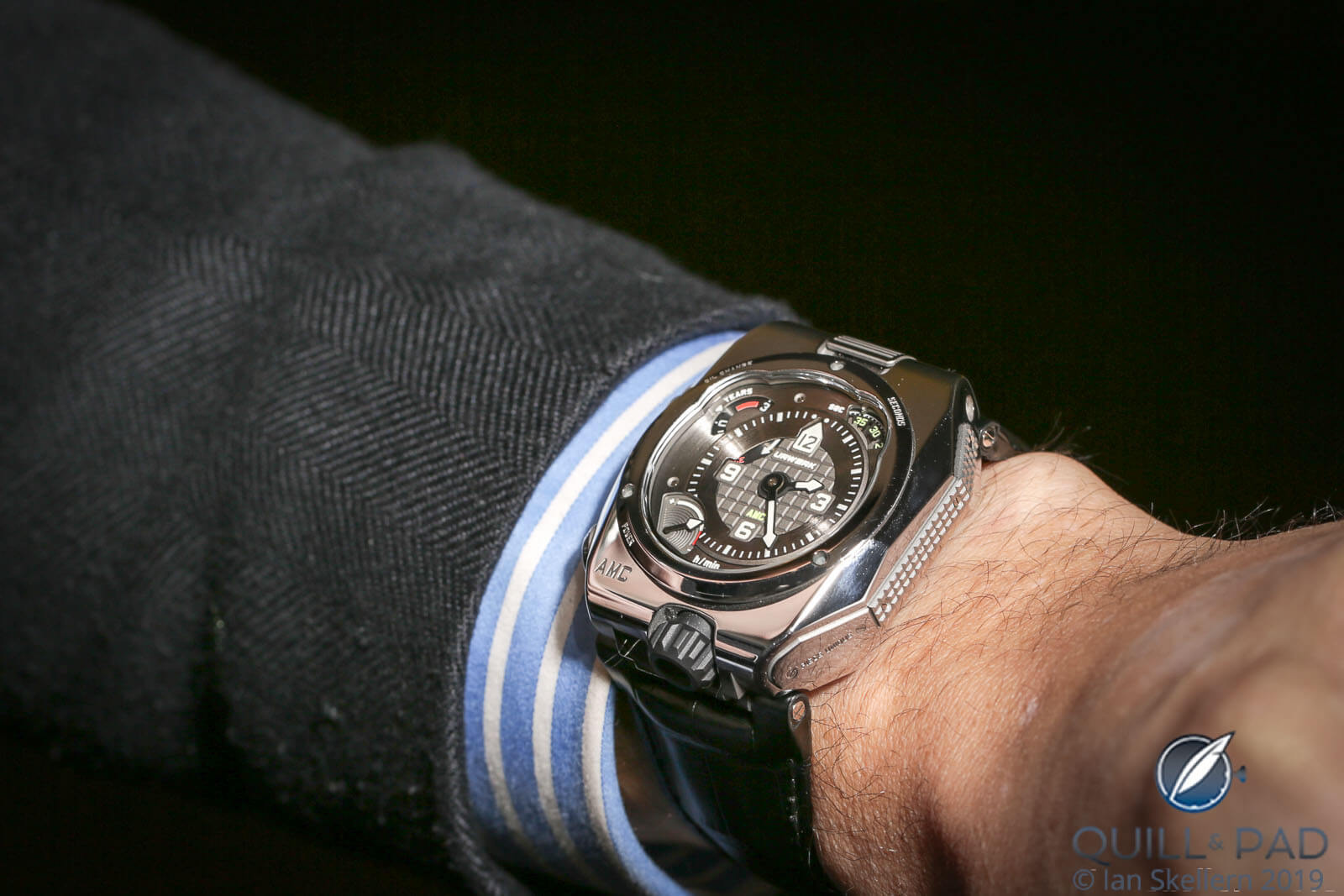
Urwerk AMC on the wrist
IS: Audacious. That’s not a word I’ve used often, if ever, to describe a wristwatch, but in the case of the Urwerk AMC I consider that an understatement. The risk in both money and time that Urwerk took in developing this watch, a risk that had a high chance of failure, must have been enormous. And the fact that this small brand pulled it off cannot be applauded and appreciated enough.
AMC takes its inspiration from Abraham-Louis Breguet’s series of Pendule Sympathique clocks (he developed the principle back in 1793), in which a pocket watch could be docked with a higher precision clock that would wind, set, and in rare cases even adjust the pocket watch’s timing rate so that it became ever more accurate each time it docked.
Urwerk has updated Breguet’s invention for the twenty-first century by replacing the pocket watch with a wristwatch and replacing the master table clock with a specially developed atomic clock. The atomic clock communicates all of its rate and time information and makes all adjustments fully mechanically.
Note to Urwerk: you should have included a photo of the watch docked with the atomic clock in the GPHG materials. The watch itself is only a fraction of the whole.
While the Urwerk AMC is my hands-down winner of this category, I also think/hope that it is likely to win the Aiguille d’Or – and if so will be taken out of this category.
Further reading:
Urwerk AMC: Atomic (Clock) Mechanical Control Is A 21st Century Version Of Abraham-Louis Breguet’s Sympathique Clocks But Much, Much Better (Geiger Counter Not Included)
The Difference Between Urwerk’s EMC And A Toyota Prius (Not As Obvious As You May Think)
Back In Black: First Live Photos Of The ‘Smart’ Urwerk EMC Black
Presenting EMC2 Time Hunter By Urwerk: Ugly Duckling Takes First Step To Swanhood
For more please visit gphg.org/horlogerie/en/watches/amc.
Quick Facts Urwerk AMC
Case: 46 x 52 x 17.9 mm, stainless steel
Movement: manual winding Urwerk caliber, ARCAP linear balance wheel, 4 Hz/28,800 vph frequency, serially operating twin spring barrels, 80-hour power reserve, automatically wound by cradle in Sympathique style
Functions: hours, minutes; years, balance rate adjustment
Remark: comes with atomic master clock base unit
Limitation: 3 pieces
Price: 2,750,000 Swiss francs
Vacheron Constantin Traditionnelle Twin Beat
SL: This is one of my favorite watches so far this year, and I would say a contender for the Aiguille d’Or.
I know: it’s not the most complex here, it doesn’t have a gazillion parts or a newfangled way of telling time. At its core it’s “just” a perpetual calendar. However, it addresses something that affects me personally as a collector with a fondness for perpetual calendars: I wouldn’t have to keep setting it every time I want to wear it. Some will say that you can use a watch winder to achieve the same result, but there’s an elegance and ingenuity that I appreciate in equipping the watch with switchable escapements such that you can be assured it’ll keep the indications accurate over a two-month period.
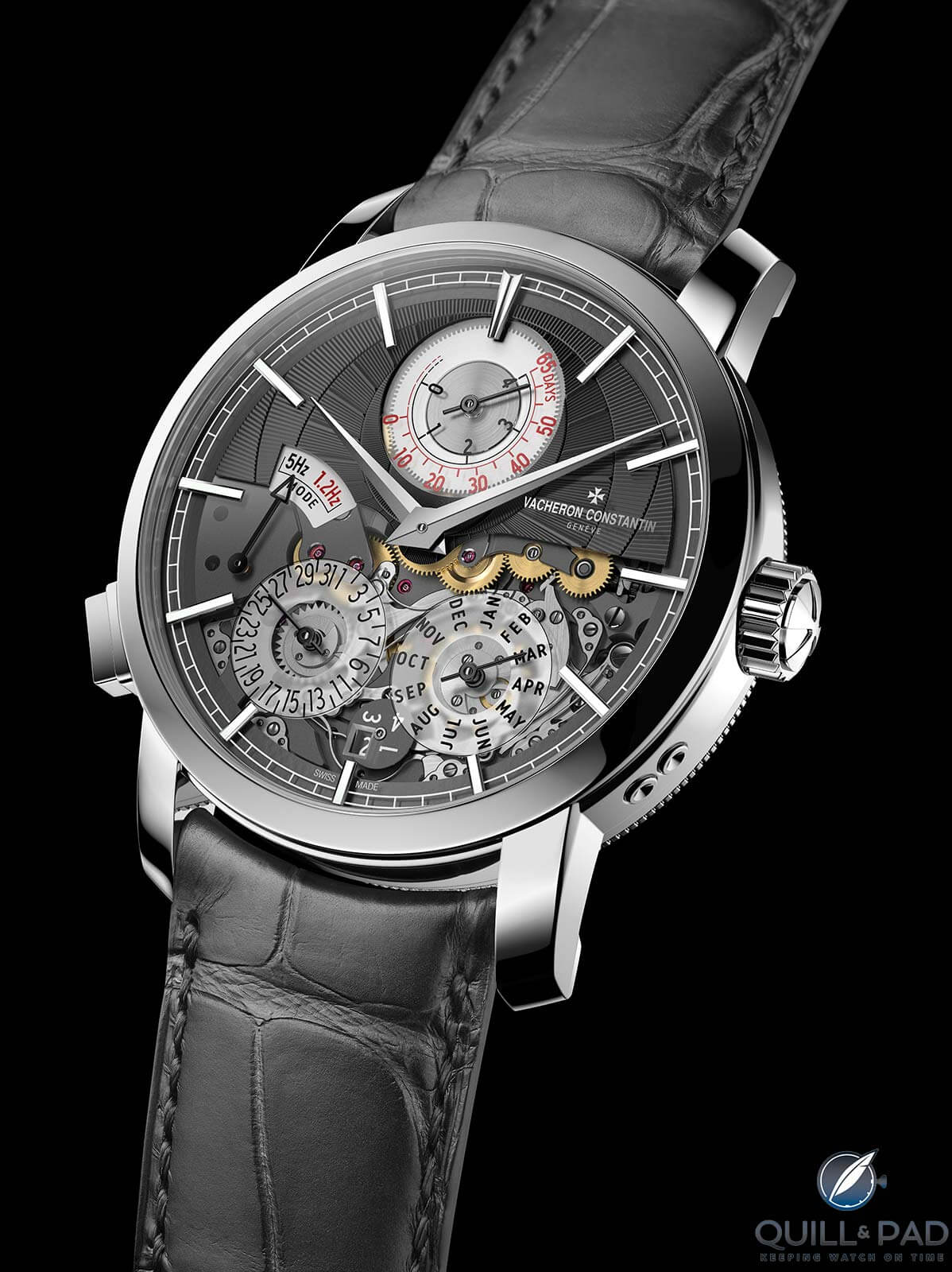
Vacheron Constantin Traditionnelle Twin Beat
JM: When Vacheron Constantin launched the Traditionnelle Twin Beat Perpetual Calendar at SIHH 2019, the buzz was like a snowball. It started small but as word spread and people began to understand just how incredible the watch was, the buzz grew and grew. The fact that Vacheron Constantin basically invented a movement that can act like a computer and go into its own version of a “sleep mode” (VC calls it “standby”) to conserve energy and boost the power reserve from four days to a whopping 65 days is astounding.
It is a magnificent solution to the problem of owning a perpetual calendar that you don’t wear everyday as your only watch. It truly solves an age old problem and could easily be the winner of this category. The main reason I don’t choose it, with all its innovation, is that it still can’t do what my winner – the Urwerk AMC – can.
TM: I’ll be shocked if this Vacheron Constantin doesn’t win the Aiguille d’Or. But if a sleeper somehow takes the top trophy, Vacheron Constantin at least deserves to win here. No haut-de-gamme watch unveiled in 2019 drew more favorable commentary, showcased more imagination, or offered more of a departure from previous norms of engineering and function.

Vacheron Constantin Traditionnelle Twin Beat
IS: When I began taking a serious interest in haute horlogerie around 20 years ago, Vacheron Constantin was a very well-respected brand that your grandfather or (older) uncle might have: it was as traditional and conservative a brand as they came. And for the last decade (or more), VC has been trying to shake off that image and appeal to a younger audience with varying degrees of success.
With the launch of the Traditionnelle Twin Beat perpetual calendar earlier this year, I think we can finally say “Job done!”, though that’s no time to rest on laurels. I’m a big fan of being able to see movements and mechanisms on the dial side, especially when that doesn’t compromise legibility, but the main draw for me is innovation. And here it’s the words “Twin Beat” that get my heart pumping.
A faster oscillating balance is more resistant to shocks upsetting the isochronism (uniformity) of each beat of the balance, and a wristwatch being worn experiences a continual series of small shocks from a multitude of angles throughout the day. So a relatively fast balance of 5 Hz provides better precision/accuracy than the modern industry-standard 4 Hz regulator.
But the downside to a faster beating balance is that is requires more energy (so shorter power reserve) and leads to higher wear. On the other hand, when a watch isn’t being worn there is no advantage to a higher beat rate as there are no (or fewer) shocks to disturb it.
There’s another big issue with perpetual calendar watches: if they stop (which can be fairly quickly if running a fast oscillator), all of the indications need to be reset: date, month, and even the year of the four-year leap year cycle, which can be a real time-consuming chore.
With the Twin Beat, Vacheron Constantin offer the best of both worlds: a fast 5 Hz oscillator for when the watch is being worn, and when off the wrist the owner can switch to a slow-beat 1.2 Hz oscillator that allows for a power reserve of up to 65 days. Not 65 hours: 65 days!
The Traditionnelle Twin Beat perpetual calendar is my second pick (it’s a draw) for best Mechanical Exception watch of 2019 – if the Urwerk AMD wins the Aiguille d’Or.
Further reading:
Vacheron Constantin Traditionnelle Twin Beat: User-Controlled Dual Frequency Offers Greater Precision, Less Wear, And Option Of Two-Month Power Reserve
For more please visit gphg.org/horlogerie/en/watches/traditionnelle-twin-beat-perpetual-calendar.
Quick Facts Vacheron Constantin Traditionnelle Twin Beat
Case: 42 x 12.3 mm, platinum
Movement: manually wound Caliber 3610QP with user-controlled dual-frequency capability; 5 Hz/1.2 Hz frequency; up to 65-day power reserve at 1.2 Hz and four days at 5 Hz; two balances and gear trains; 480 components, Geneva Seal
Functions: hours, minutes; power reserve indication; date, perpetual calendar with date, month, leap year; frequency mode
Price: €283,000, boutique edition only
Predicted Winners
Martin: Audemars Piguet Royal Oak Selfwinding Perpetual Calendar Ultra-Thin
Tim: Vacheron Constantin Traditionnelle Twin Beat
Sean: Vacheron Constantin Traditionnelle Twin Beat
Joshua: Urwerk AMC
Ian: Urwerk AMC (but I think that will win the Aiguille d’Or and, if so, I would have to call a draw between the Ulysse Nardin Freak NeXt and the Vacheron Constantin Traditionnelle Twin Beat perpetual calendar)
You may also enjoy:
Our Predictions In The Ladies Category Of The 2019 Grand Prix d’Horlogerie de Genève (GPHG)
Our Predictions In The Chronograph Category Of The 2019 Grand Prix d’Horlogerie de Genève (GPHG)
Leave a Reply
Want to join the discussion?Feel free to contribute!





















































I’ll keep my opinion on the Urwerk to myself, as it’s too easy a target. Don’t really mind what wins the Aiguille D’or, as last year’s beast from Bovet helped me realise the top prize has as much to do with audacity as any other quality. This category however, belongs to Vacheron for a brilliant idea perfectly executed that will hopefully, not too far in the future become a standard for QPs, at a less astronomical cost. One can hope!
agreed
The VC twin beat for me with the Ulysee Nardin Freak next second.